Working in areas often associated with domesticity and family are frequently looked down upon in the fine arts. There is often excessive sentimentality; precious baby pictures and those secretive images best locked away in a chest hidden at the back of a remote closet in the basement. However, this is certainly not the case in the artwork of Alberto Aguilar. Cultivating a climate of collaboration with his wife and children has become a healthy means for investigating serious (though frequently bizarrely humorous) modes of contemporary art practice. The COMP Magazine recently visited the Aguilar home near Midway airport to discuss why play is useful, why not all Mexican artists are muralist and listened to a delightful musical performance by his kids.
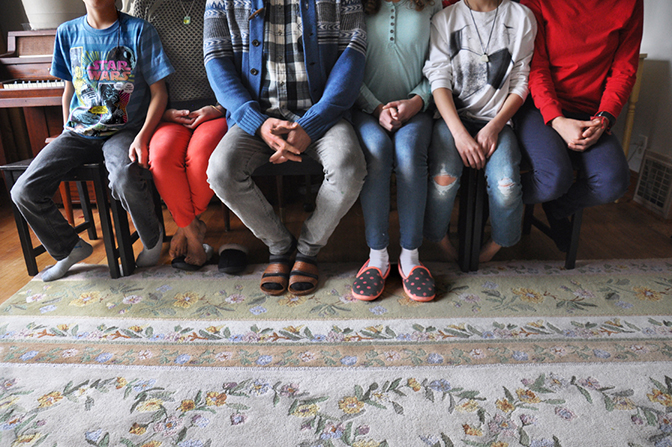
Alberto Aguilar, new media artist, with family, Chicago, IL, 2014
You value family. This is clearly evident. Your wife and kids often participate in your artistic investigations. When and why did you realize that this was an area with such potential for serious (yet playful) inquiry? Is there any specific family collaboration or experience that you can share?
Some people think I solely make family art or art in the domestic realm. I like to say that I try to incorporate all aspects of my life into my art making process. My family life happens to be the largest component so it is the one that is most prominent. I do value family time though. I realized that it had a lot of potential immediately upon having my first child. Of course I thought of this in a more traditional fashion by making paintings and drawings of mother and child. I made quite a few of these. But as I had more children and my idea of art became more open I realized that it had potential for something bigger. I used to keep a clay jar where I would put in all the things that were potential choking hazards. After a while this collection of objects got bigger and more interesting. I never did anything with these objects but I always knew they were meaningful and visually potent as a whole. A realization that I had and actually did something with was compiling these little silly songs I make while living out my daily life. I make songs on varied topics such as food, body parts, pooping, the changing seasons, life and death, just about anything really. These come to me at any given moment while living out my life but mostly while interacting with my children. I started to recognize that their was something to these ditties, something universal that maybe people could relate to with or without having kids. So I began to collect them on a tape recorder immediately upon creating one. This collection got bigger and bigger and more layered and meaningful as a compilation. I made a total of three compilations and called them House Music 1, 2 and 3. To this day I still record these songs but now I do it on my my phone so they are even more immediate from conception to documentation. The last one I made is about a wise piece of cheese trying to convince its listener not to eat him.
I still make mother and child images but now I use a digital camera and it involves more than one child. After going through an art museum (in whatever city we find ourselves) and reaching a breaking point we go to a rest area in that museum. There they let out all their pent up energy after viewing art, being asked to not touch stuff and to stay quiet. Once there I start taking photos of them fighting, playing, teasing, being reprimanded or finding comfort in my wife’s arms. This has become known as a series called Rest Area.

Alberto Aguilar, Rest Area (Dali Museum St. Petersburg, FL), 2012, Digital image
In addition to being an artist, you are an educator. Do you see any influence teaching has upon your art practice? Also, are there any items that you hope to instill in your students?
Teaching is also a large component of my life therefore an important aspect of my art practice. Teaching is a pliable thing, a raw material, a place to test out ideas. And that is what I have done and continue to do in the classroom. Art appreciation has been the most generative class that I have taught regularly since I first started teaching. When I first started teaching this class I would show things that would challenge and confuse my students of what art could be. Similar things that challenged me while in art school. Things that continued to challenge me freshly out of graduate school. But what ended up happening is that in showing this work to my students it made me start to like it and understand it and I began to incorporate some of these ideas in my work. The other thing that I became interested in by teaching art appreciation is how to make complex ideas in art more accessible. These students were non art majors and had little to no experience with art. I would do things to make art more relatable to their own lives and give hands on projects. I eventually got rid of the text book. This had an affect on my own work and it gave me a desire to make it more accessible and more relatable. There was a point when I finally arrived at that idea. Year to year I would ask my students to write a review of my work after checking out my website and one year they came back with responses where I felt they were connecting to it. This excited me and this is when I started to actively exhibit my work. It was around 2009. I teach art appreciation but I think it is so much more. I think it is about teaching people how to appreciate life and time as it passes and how to become more sensitive to the world around them. These are tools they can carry with them over a life time and that is the main reason why I choose to teach this class. It has a direct affect on my students that I can see before the semester’s end.
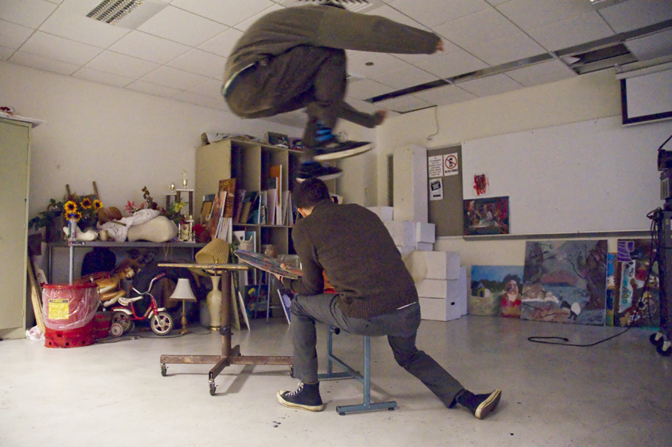
Alberto Aguilar and Alex Cohen, Clear Painter, 2009, Digital image
I teach painting and drawing also but even here I use it as a way to teach other things. In one class a while back I had a student like no other. He had a lot of playful energy and would constantly interrupt the class especially when I would give painting demonstrations. I liked it and played off his energy. One day he was jumping over stuff in the classroom so I thought it would be funny if jumped over me as I gave a demo. We had to do a several takes (he kicked my head a few times) but he eventually cleared over me. We formed a life long bond and still make work together. Just this past year at art expo we did a performance together where we set up a table with cotton balls on it and bananas underneath. As people gathered to figure out what its meaning was, we would come out of no where and both jump over it. My relationship with him is an extraordinary exchange. It’s one that you rarely come across in teaching but when you do it’s great and generates work on both ends. I taught him how to make play and interruptive behavior into art and he taught me how to jump over things.
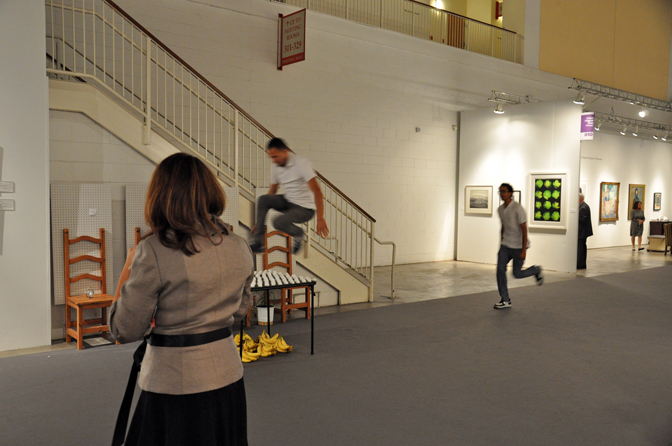
Alberto Aguilar, Clear Bananas, 2014, Performance at Art Expo Chicago
At times, there is an ephemeral and physical nature to your artwork. In “Home Field Play” at the MCA, a dining table was transformed into a mirrored ping-pong table complete with other items one finds in one’s home. What was the impetus of this project? What did you learn from this experience?
The MCA in Chicago invited me to be in an exhibition titled Homebodies.This was about artists that make work in and around home. They wanted to show a couple of my Domestic Monuments in photo form. As the date drew near they also invited me to create an interactive installation in the main lobby outside of the gallery where the exhibition was to take place. I was confronted with a big problem of what I would do with this huge space that would relate to home allow visitors to interact.
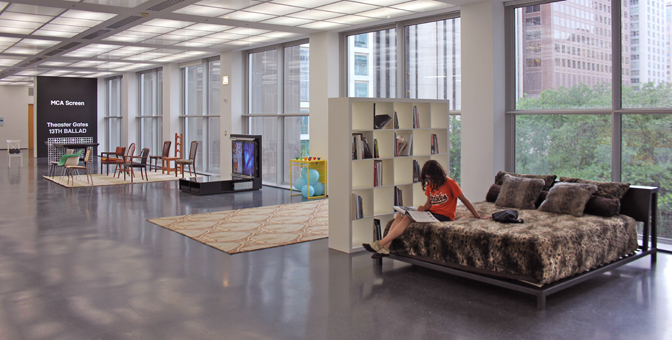
Alberto Aguilar, Home Field Play, 2013, Interactive installation at Museum of Contemporary Art made with repurposed furniture
Of course this came with some anxiety but one night as I lay in bed I thought about a work created by my children that I titled Sensitive Equipment.
It involves keeping up a balloon with hand bells on an area carpet. It is simultaneously a game and a sound score. You play it within the area carpet and it is finished once that balloon falls on the ground. The day it was created I came down the stairs in our home and I saw them playing it and said to myself “I want to play this”. As I played I realized I needed to record it. So I made a video and called it Sensitive Equipment because one of my kids said that phrase while I recorded us playing and I thought it was fitting.
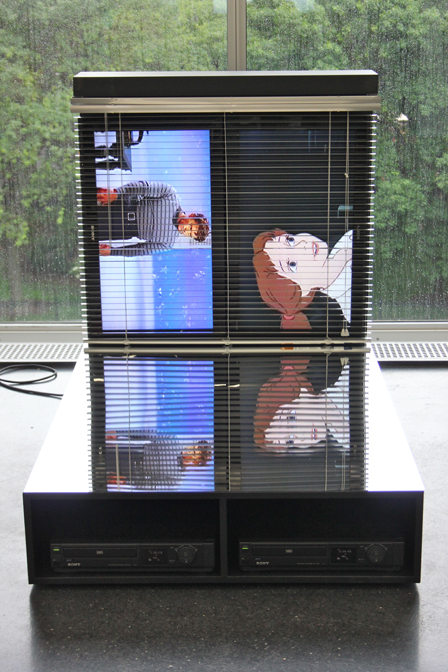
Alberto Aguilar, Obscure Time Device (Home Field Play), 2013, Entertainment center, monitors, VCR’s, video tapes, mini blinds
As I laid in bed thinking about this work I came up with the idea of creating various stations in the museum for people to play and interact. Each station would be made up of home furniture that would be slightly modified to create these stations. The idea for the ping pong table also came out of my home. We would regularly convert our dining table into a ping-pong table that I play with my kids or with dinner guests after eating too much. It made sense that this would be a station as well but this time with the added component of a mirror to create a confusing obstacle. Also I invited my friend, Edra Soto, to make a net for the table in the fashion of her porch/window fences. The other stations were a king size bed covered in fur next to a bookshelf for people to read and rest, an entertainment center with double televisions turned on their side, obscured by mini blinds, reflected in a mirror and hooked up to VCR’s that guests could play choosing from an assortment of video tapes and finally an assortment of chairs borrowed from museum staff that people could arrange, stack and sit in.
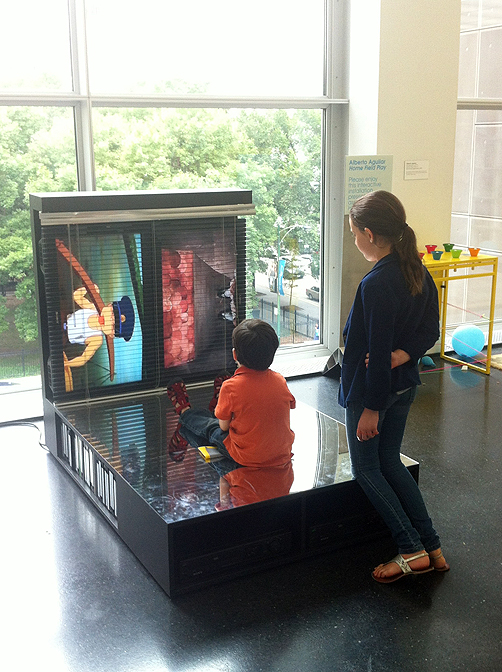
Alberto Aguilar, Visitors watching Obscure Time Device (Home Field Play) at MCA Chicago, 2013, Digital image
Some things I learned from this experience was to value children’s play and to trust my intuition and ideas that come at any given time, even as I lay in bed. The main thing that I leaned though was to let go of control. After the installation was complete and I had to let it go and put it into the hands of museum visitors. I was afraid that they would mess it all up but it generated surprising things that I could never anticipate. For instance I did not realize that children would sit on the mirror surface of the entertainment center. This seems like a small thing but when they sat on the mirror watching TV they were also reflected within the work that they were held captive by. This added a deeper meaning for me.
I tend to chuckle (and laugh out load) when viewing the Domestic Moments series. You appear to be invading people’s homes and creating temporary sculptures out of the occupant’s furniture and other household items. In part, I see an affinity with the work of Erwin Wurm. Can you describe the intent and process of these temporal artworks?
I used to show Erwin Wurm’s work to my students and these works definitely influenced the domestic monuments. They gave me permission to make temporal works that were also playful. This idea made perfect sense since I used to get frustrated of having to take care of all the work that I would produce and never sell. I started by making these monuments in my home but soon realized that I could do it in others’ homes as well, sort of as an unintended collaboration with anyone.
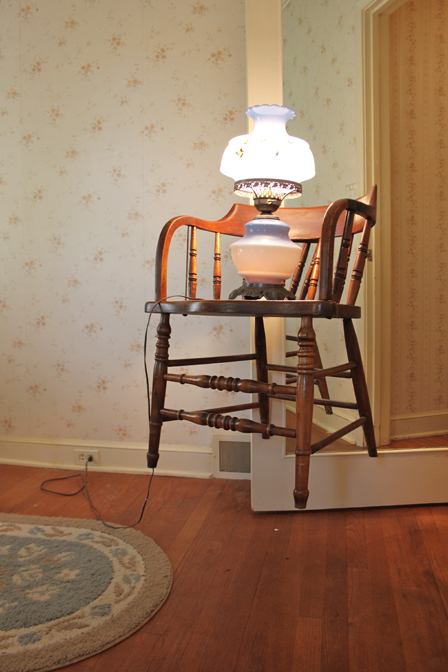
Alberto Aguilar, Chair Lift (For Cara Megan Lewis), 2014, Digital image
I’m glad you think the Domestic Monuments are funny because they sometimes are to me as well. It is the play between objects that would not usually come together, but when they do, new meaning is created. They come out of my visits to people’s homes. I am invited to come, they give a tour and then then let me loose to look around and get intimate with their space and their stuff. I create a few of these monuments using their personal belongings and then I take photos of them. Afterwards I retrieve the home owner and I take them on a tour to look at the monuments in their setting. They are always excited to see the outcome of how I bring together their objects through a completely different logic and in ways they would not think of. For me the choices are aesthetic, humorous, or create an illusion but for them it is so much more. Because they have a history with these objects the implications are deeper and they make meaning out of my choices. Sometimes it’s like I am acting as a therapist without trying.
This past summer I was invited by my friend Cara Megan Lewis to come to her recently deceased grandmother’s home in Shubert, Nebraska (population 150) to be an artist in residence. I took my whole family of course and life just slowed down for the entire week we were there. I made couple drawings but it was moments before we were walking out the door to go back home that I made the monument that Cara was expecting me to make. I made it in the bedroom where my wife and I were sleeping which happened to be the grandmothers bedroom. I usually title these work by stating facts of what is going on in the picture and those usually have deeper implication to the person as well. Cara was very grateful for the work even though it currently only exists as an instagram post.
What do you have planned for 2015? Are there any mischievous family projects on the horizon?
The big thing is that I am Crossing Boundaries resident artist through Arts + Public Life and Center for the Study of Race, Politics and Culture at U of C for the next five months. As part of the residency I have decided to associate every exhibition that I am part of with this residency along with all other aspects of my life. Here is list of those things
January:
Alberto Aguilar
Celebratory System
at Kitchen Space
Alberto Aguilar will make an installation and give directives for the gallery directors to hold a series of celebratory dinners in Kitchen Space throughout the duration of the exhibition. This system of celebration comes out of discoveries made by Alberto in his home and through hosting
similar dinners on his own.
also on view:
Curated by Alberto Aguilar
inaugurating in a new space adjacent to the Kitchen
Alex Cohen
Silly Through Pain
at Window Sill
Alex Cohen installs painting and ceramics on the pane and the sill of the
window and offers the viewer a new mode of observation. In this
installation one is allowed to see the world as Alex Cohen both looking
out and within.
In March I have a mini residency at the Luminary in St. Louis. There I am part of a group show in titled Counterpublic in which I will make several Domestic Monuments from home visits to St. Louis residents. Also i will display hand painted sale sign in a Mexican grocery store called El Torito in St. Louis as well.
Early April:
Material Normal Monumental
A diverse group of Hispanic/Latino/a artists show works using everyday materials to present varied perspectives around the monument and monumentality. Although grouped through these simple common factors, each artist in this exhibition conceptualizes complex individualities about hybridity through their unique contribution to the exhibit. These blended identities are characterized by the particular nuance of being Hispanic/Latino/a in the United States (currently residing in Chicago), often existing within multiple languages and cultures while trying to to make a personal contribution to contemporary art discourse.
Participating Artists: Alberto Aguilar, Maria Gaspar, Jorge Lucero, Victoria Martinez, Maddie Reyna, Edra Soto, Rafael E Vera with an essay by J. Gibran Villalobos and Wil Ruggiero (JGV/WAR)
In late April I am having a solo exhibition at 4th Ward Projects in Hyde Park where I will demarcate my moves within this 17‘x17’ space.
This all ends with an exhibition sometime in May at the Arts Incubator where I will show the various boundaries that were crossed during my residency and maybe some work as well.
In June I am keynote speaker in an art education conference in Colorado where my family will present right at my side as performance art.
Alberto Aguilar teaches at Harold Washington College in Chicago IL. He has presented at the Queens Museum in New York and the Nerman Museum of Contemporary Art in Kansas. His work has been exhibited at the Elmhurst Art Museum; The Museum of Contemporary Art in Chicago; Steven Zevitas Gallery in Boston, MA; Crystal Bridges Museum in Arkansas.
To view additional work by Alberto Aguilar, please visit: http://albertoaguilar.org/
Interview and portrait by Chester Alamo-Costello


